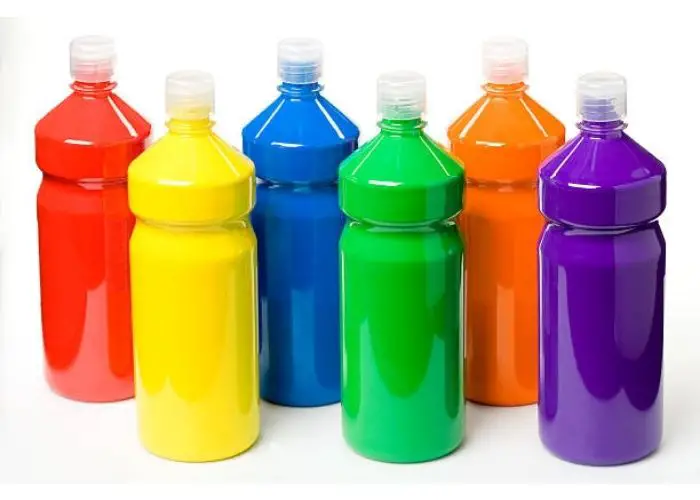Did you know that acrylic paints are considered hazardous materials? Do you have acrylic paint that you need to get rid of? Are you not sure how to dispose of it properly? If you’re not sure how to dispose of it, don’t worry – we’re here to help.
This blog post will discuss the best ways to get rid of acrylic paint. We’ll also talk about related topics, such as recycling and proper storage.
So, whether you’re an artist or just have a few tubes of paint lying around, read on for tips on how to dispose of acrylic paint safely.
How to Dispose of Acrylic Paint
- Giving your excess paint to charity
- Recycling acrylic paints that have been used up
- Throwing non-toxic acrylic paint away after letting it dry out
- Take toxic acrylic paints to your local hazardous waste disposal center
What Is Acrylic Paint Used For?

Acrylic paint is a type of paint made from pigments suspended in a synthetic resin. It is popular among artists because it dries quickly, can be used on a variety of surfaces, and can be easily mixed with other colors.
Acrylic paint can also be diluted with water, which makes it ideal for painting large areas.
In addition to being used by painters, acrylic paints are also commonly used for crafting and décor projects. But, is craft smart acrylic paint good?
Craft Smart acrylic paints are high-quality and offer even coverage, vibrant colors, and great consistency.
Is Acrylic Paint Considered Hazardous Waste?
No, however, there are some factors to consider when deciding how to dispose of your acrylic paint. Acrylic paint is a synthetic polymer made from plastic and pigment.
It is water-based, so it is not flammable and does not emit fumes like oil-based paints. However, acrylic paint can be toxic if ingested, so it should be kept out of reach of children and pets.
Is acrylic paint an aquarium safe paint? Learn more.
Is Acrylic Paint Biodegradable?
No, it is not. Acrylic paint is a plastic made from petroleum, and like all plastics, it does not break down in the environment.
Unfortunately, this means that it can last for centuries in landfill sites, and when it ends up in the ocean, it can be ingested by marine life.
However, there are some steps you can take to ensure that your acrylic paints do not end up in landfills or the ocean.
Is Acrylic Paint Eco-friendly?
As we said above, acrylic paint is not biodegradable. Once it is applied to a surface, it will remain there indefinitely. In addition, the manufacturing process of acrylic paint releases toxic chemicals into the environment.
For these reasons, acrylic paint is not considered to be eco-friendly. If you are looking for a more environmentally friendly option, consider using water-based or solvent-free paints instead.
Is Acrylic Paint Recyclable?
You can recycle your unwanted acrylic paint by taking it to a local recycling center that accepts unwanted paint. However, the long answer is a bit more complicated.
While you can recycle your unwanted paint, the recycling process is not as straightforward as other materials like glass or plastic.
First, the paint must be sorted by type and color. Once the paint is sorted, it is then cleaned and processed into new recycled paint.
The process of sorting and cleaning the paint takes more time and effort than other materials, which is why some recycling centers do not accept acrylic paints.
However, more and more centers are beginning to accept unwanted paint as the demand for recycled products increases.
Is Acrylic Paint Toxic?

Yes, it can be. Acrylic paint is made from pigments that are suspended in synthetic resin. When the paint dries, the pigments are released into the air. Inhaling these particles can cause respiratory problems, such as asthma.
In addition, some people may be allergic to the chemicals in acrylic paint, which can cause skin irritation. If you are concerned about the toxicity of your paint, consider using water-based or solvent-free paints instead.
These types of paint do not release harmful chemicals into the air and are less likely to cause allergic reactions.
Read more to learn if acrylic paint is safe for babies. Also, we have the following article that you might find interesting to read. Is acrylic paint toxic on cats, and is acrylic paint safe for dog paws?
How to Dispose of Acrylic Paint Safely
When it comes time to dispose of excess or unused acrylic paint, it’s important to do so in a safe way for both the environment and your local sewage system.
The first step is to check the label of your acrylic paint to see if it is oil-based or water based paint. Water-based acrylics can be diluted with water and safely poured down in a pit, while oil-based acrylics must be disposed of as hazardous waste.
Once you’ve determined the type of paint you’re dealing with, follow these guidelines:
Dispose of water-based acrylics
For water-based acrylics, add an equal amount of water to the paint and mix thoroughly. Once diluted, the paint can be poured down into a pit.
Dispose of oil-based acrylics
For oil-based acrylics, contact your local solid waste management district to find out where you can take hazardous waste for disposal. Never pour oil-based paints down the drain!
On the other hand, you also check if the acrylic paint is toxic or non-toxic. Here’s how to deal with both.
Dispose of non toxic acrylic paint
If the label on your acrylic paint says “non-toxic,” you can safely dispose of it in the trash.
1. Let the paint dry out first
To do this, pour the non-toxic acrylic paint into a container with a lid and leave it in a well-ventilated area until completely dry. You can speed the drying time by adding absorbent materials like kitty litter, paint hardener or sawdust.
2. Throw it away in a garbage can with a lid
Once you have dried paint, you can simply throw it away in the trash. Be sure to put it in a garbage can with a lid to prevent children or pets from getting into it.
Dispose of Toxic Acrylic Paint
1. Secure the Lids on the Containers
Make sure all the lids on the containers are tightened so that there is no chance of the paint spilling.
2. Take the paint to Your Local Hazardous Waste Facility
Most communities have at least one hazardous waste facility where you can take your unwanted paint. To find the nearest facility, contact your local solid waste management district.
Read also: Is acrylic tank manufacturing still in business?
Can You Pour Acrylic Paint Down the Drain?
Although it is a water-based paint, once it dries, it becomes plastic, which means it shouldn’t go down the drain. Once it’s poured down the drain, the paint can dry and solidify, leading to clogs.
It can also contaminate water supplies and harm wildlife. So what should you do with leftover paint?
The best option is to take it to a hazardous waste facility, but you can also let it harden in the can and then throw it away. Whatever you do, don’t pour it down the drain!
Can You Wash Acrylic Paint Brushes in the Sink?
Many people assume that you can’t wash acrylic paint brushes in the sink, but this isn’t necessarily true.
While it’s always best to clean your brushes immediately after use, sometimes life gets in the way, and you cannot do this right away.
If you find yourself in this situation, you can wash your brushes in the sink, as long as you take a few precautions.
First, make sure that the water is not too hot, as this can damage the bristles. Second, use gentle soap and avoid scrubbing too harshly.
Finally, rinse the brushes thoroughly and allow them to dry completely before using them again.
How to Dispose of Acrylic Paint Water
When you’re done painting for the day, you’re left with a cup or two of murky water that’s filled with paint pigment and other bits of debris.
You might be tempted to pour it down the drain, but that’s not the best way to dispose of acrylic paint water. So here’s what you should do instead:
First, let the paint water settle for a few minutes so that the pigment and debris can settle to the bottom. You can use cat litter for this process. Then, carefully pour the clear water into another container.
You can dispose of this water down the drain. Now you’re left with the sludge at the bottom of the first container. This can be disposed of in a few different ways.
One option is to mix it with an absorbent material like sawdust, kitty litter, paint hardener, or sand. Once it’s fully absorbed, you can throw it away in your regular trash.
Another option is to solidify the sludge by adding gelatin or cornstarch, then scooping it into a plastic bag and throwing it away.
Can You Recycle Acrylic Paint Bottles?

Yes! you can recycle acrylic paint bottles. Most recycling facilities can accept empty paint containers as long as they are clean and dry. However, there are a few things to keep in mind before recycling your old paint cans.
First, check with your local recycling center to see if they have any specific requirements for paint cans. For example, some centers may require that the cans be crushed before they are accepted.
Second, remove the lids from the cans and throw them away separately. Lids are often made of a different type of plastic than the cans themselves, so they need to be recycled separately.
Finally, if your paint cans are still half full, don’t worry! You can still recycle them as long as you empty them first.
Simply pour the leftover paint into a container that can be sealed tightly, such as a jar or plastic bag, and throw it away in the garbage.
Warnings on Acrylic Paint Disposal
- Don’t pour acrylic paint down the drain
- Don’t wash it down the sink
- Can be recycled
- Empty paint cans before recycling
Paint Items You Might Need to Dispose of
- Old paint brushes
- Paint cans
- Paint water
- Leftover paint
- Rags
- Cat litter
Can I Throw Away My Empty Paint Cans?
While it’s true that most paint cans can be recycled, there are a few things to keep in mind before you put them in your recycling bin.
First, make sure that the cans are completely empty. If there is any paint left in the can, it needs to be disposed of properly. You can usually do this by taking it to a local hazardous waste facility.
Second, check with your local recycling facility to see if they accept paint cans. Some facilities have special requirements for paint cans, so it’s best to give them a call before you try to recycle them.
And finally, if you’re not sure what to do with your empty paint cans, you can always just throw them away. Just put them in the garbage, not the recycling bin!
What Can You Do with Dried-up Acrylic Paint?
Unfortunately, there is not much that you can do with dried paint. The best option is to throw it away in the garbage.
However, if you’re feeling creative, you could try using it as a crayon or colored pencil! Just scrape the paint off of the container and into a bowl, then add a little bit of water and mix it up.
Once it’s the desired consistency, you can use it just like any other crayon or colored pencil. many artists choose acrylic paint as their go to paint for wall murals and wall art.
FAQs
How do you get rid of acrylic paint?
With a few simple household supplies, you can easily get rid of any unwanted acrylic paint. One method is to simply soak a cloth in warm water and then scrub at the paint until it comes off. You can also try using white vinegar or nail polish remover to break down the paint. If these methods don’t work, you may need to sand the surface to remove acrylic paint.
What can you do with unused acrylic paint?
If you have any unused acrylic paint, the best thing to do is donate it to a local school or community center if you have a good amount of paint leftover. These organizations are always in need of supplies, and your unused paint will definitely be put to good use!
How do you clean up after using acrylic paint?
The best way to clean up after using acrylic paint is to use soap and warm water. Simply wash your hands or any other surfaces that have paint on them with soap and water, and the paint should come right off. If the paint is still wet, you can also try using a damp cloth to wipe it up.
How do you store acrylic paint?
Acrylic paint should be stored in a cool, dry place. The ideal temperature for storing acrylic paint is between 50 and 70 degrees Fahrenheit. If you store your paint in a too cold place, the paint may become thick and difficult to use. If you store your paint in a too hot place, the paint may start to separate and become unusable.
What can I do with leftover acrylic paint on palette?
The best thing to do with leftover acrylic paint on your palette is to scrape it off and into the garbage. Once the paint is dry, it will be very difficult to remove from your palette, so it’s best to get rid of the hardened paint as soon as possible. If you’re feeling creative, you could also try using the leftover paint to make a new color! Just mix the paint on your palette and see what you come up with.
How to dispose of acrylic paint tubes?
Acrylic paint tubes can be recycled, but it’s best to check with your local recycling facility first to see if they have any special requirements. You can also try to reuse the tubes for other purposes, such as storing small items or holding pens and pencils. If you’re not sure what to do with your acrylic paint tubes, you can always just throw them away. Just put them in the garbage, not the recycling bin!
Conclusion
Well, there you have it! That’s everything you need to know about acrylic paint disposal. Remember, the best way to dispose of unwanted paint is to take it to a local recycling center.
They will be able to recycle the paint and keep it out of landfills properly. And if you have any leftover paint, be sure to store it properly so that it doesn’t become hazardous waste.
Thanks for reading, and Happy Painting!











Leave a Reply